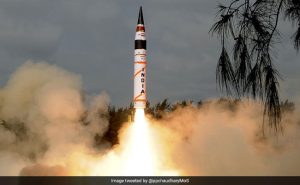
https://bharatshakti.in/defence-planning-covering-the-achilles-heel/
Editor’s Note
This article is the fourth in the series of articles on Defence Procurement by the author. His earlier articles Defence Procurement – Strengthening Our Achilles’ Heel, Knowledge of Defence Acquisition – Educating Our Achilles’ Heel and Defence Acquisitions: Integration of the Achilles Heel have already been published on this website.
In this article he explores the weaknesses of the system that remain largely unaddressed, leading to reforms in defence procurement procedures not having the desired effect. He also states that the government is quite aware of these weaknesses.
Defence Planning: Covering the Achilles’ Heel
Dwindling defence budget allocations highlight the widening gulf between the growth of India and its defence preparedness. Reports suggest that the Make in India program is floundering. The Rafael deal is slowly wading into turbulence. Critical deficiencies in small arms and ammunition will continue for the next decade. Meaningful indigenization continues to remain beyond visual ranges like the last 70 years. Our litany of woes in defence procurement is overflowing at the brim while cutting edge technologies and weapons are being inducted into PLA and China is ensnaring our strategic neighbourhood in debt traps. The String of Pearls is now a set of Claymore mines directed at the heart of India. The overall portents are gloomy.
Paper Perfect
 Our defence planning is flawless on paper. The Long Term Integrated Perspective Plans(LTIPPs), Individual Service five-year plans, bi-annual acquisition plans, capability development and technology development plans are perfection personified. The DefenceAcquisition Council (DAC), Services Capital Acquisition Plan Council Higher Committee and the Services Capital Acquisition Plan Categorization Committee consisting of our best defence planning professionals regularly discuss and debate defence procurement issues to come out with seemingly logical plans. However, on ground , most come close to naught. What one witnesses with eyes wide shut is that our planning is so fatally divorced from reality that the man on ground must fight with what he has. What he has is fast dwindling with no replacements in sight.
Our defence planning is flawless on paper. The Long Term Integrated Perspective Plans(LTIPPs), Individual Service five-year plans, bi-annual acquisition plans, capability development and technology development plans are perfection personified. The DefenceAcquisition Council (DAC), Services Capital Acquisition Plan Council Higher Committee and the Services Capital Acquisition Plan Categorization Committee consisting of our best defence planning professionals regularly discuss and debate defence procurement issues to come out with seemingly logical plans. However, on ground , most come close to naught. What one witnesses with eyes wide shut is that our planning is so fatally divorced from reality that the man on ground must fight with what he has. What he has is fast dwindling with no replacements in sight.Soon it will be like 1962. We could then explain that we were a new and poor nation with no defence preparation or strategic awareness. Today, being a global power with a ten trillion-dollar economy is an Indian aspiration. Future generations of India will, however, be unforgiving towards defence planners who could not arm their nation commensurately. Defence procurement planning is a “Paper Tiger”. I will discuss only the Macro and Mid-level planning since the Micro level is an outflow of the sieve from the top.
Macro Planning Woes
The Clarion Call of Make in India. In Tirupati temple when one-person chants ‘Edukondalavaada – Govinda- Govinda’(propitiating the lord of the seven hills-Lord Balaji to shower his divine blessings)the resounding echo is ‘Govinda–Govinda’, in unison from the omnipresent crowd there. Similarly, once our Prime Minister gave the clarion call of ‘Make in India’; brilliant handpicked bureaucrats, intelligent and visionary Generals, glib talking nouveau– defence industrialists, inventive scientists and manufacturers of all hues went into huddles and came out with brilliant Make in India solutions drawn on paper.
A new DPP was published, private industry was roped in, foreign OEMs were invited, Strategic Partnerships were sculpted, Ammunition Parks were envisaged, Defense Industrial Corridors planned, and many activities started. Single point focus – ensure ‘Make in India’ happens. It was to be the panacea for all our defence procurement problems.The reality is now sinking. Foreign investment through ‘Make in India’ is minimal. No OEM has set up a plant here. There has been no significant jump in defence contracts – financially, volumetrically or substantially. Big ticket deals and fancy indigenous projects are mired in the morasses of the many mini fiefdoms which constitute the MOD.
Sampling of Macro Planning Woes. There are many flaws in our macro planning. Here are samplings of some major drawbacks: –
- OEM Incentive. Why would a OEM come to India to set up a plant and part with technology unless he was
 sure of an order? To give him an order one must go through the DPP 2016 procedures. Anyone with elementary knowledge knows that it takes a decade or more for a case to mature to contract stage. Which OEM will relocate to India, invest and wait for a decade to go through a competitive process? I am yet to see one.
sure of an order? To give him an order one must go through the DPP 2016 procedures. Anyone with elementary knowledge knows that it takes a decade or more for a case to mature to contract stage. Which OEM will relocate to India, invest and wait for a decade to go through a competitive process? I am yet to see one. - Strategic Partnership. Elementally, the strategic partnership guarantees an order in perpetuity to the chosen partner. That goes against all principles of promotion of competitiveness and financial probity. Even the most loyal and subservient bureaucrat has not been able to put it through since his neck is on the line.
- Budget vs Scale. Dwindling defence budgets for modernisation and the scale expected from Make in India are incongruent. You can only cut your cloth as per your purse. Since we do not have the money, defence preparedness has lagged. But that aside even if budget is allocated, there must be mature projects to spend on. Catch22!
- Transforming Indigenous Capacities. Existing production capacities and research expertise were set aside to let inexperienced private sector operators in. Good bad or ugly there have been huge investments into our inefficient R&D and lethargic public-sector units. MOD efforts have been unsuccessful to make them perform by either transformation/reform. Complex issues need special handling. Why not get NITI Aayog involved? Is Defense procurement and planning not part of India or does it not need transformation?
- Planning Sans Expertise. How does one plan to set up ammunition parks when the respondents have no technological capability or explosive licenses. Getting an explosive license is a very complex exercise. Only few players have it. Tom Dick and Harry cannot set up and operate ammunition production units.
- Defense Industrial Corridors. When no significant new orders or initiatives are in the pipeline what is the use of establishing Defense Industrial Corridors? Whom will they serve? What will they produce in a Make in India concept which itself needs a redo?
- Export Policy. Leading countries sustain their defence expenditure including R&D through export. They sell equipment to a country and milk it for life through spares and services. They have well laid out policies for this. It not only gets you capital but also projects your power and helps build alliances through dependencies. How can one develop defence Industry if the export policy is a restrictive wall? The cornerstone of self-sufficiency hinges around making others paying for it. Our skewed export policy still suffers from the non-alignment hangover.
 Can‘Make in India’ Happen? Does it mean that Make in India cannot happen? Of course not. Make in India can happen and has happened. Unfortunately, no one has taken heed or built on the successes. Why? People have simply not understood how ‘Make in India’ can happen. There are many hues. For quick results it could be an old case realigned to fit into the ‘Make in India’ theme and make it grow from there. It has happened with the 155mm ULH: where a pure import-oriented case has been converted into part ‘Make in India’ with assembly of guns in India and global manufacturer of spares, in the long term, in India. The K9 Vajra represents a higher degree of ‘Make in India’ with a major portion of the gun being manufactured in India.
Can‘Make in India’ Happen? Does it mean that Make in India cannot happen? Of course not. Make in India can happen and has happened. Unfortunately, no one has taken heed or built on the successes. Why? People have simply not understood how ‘Make in India’ can happen. There are many hues. For quick results it could be an old case realigned to fit into the ‘Make in India’ theme and make it grow from there. It has happened with the 155mm ULH: where a pure import-oriented case has been converted into part ‘Make in India’ with assembly of guns in India and global manufacturer of spares, in the long term, in India. The K9 Vajra represents a higher degree of ‘Make in India’ with a major portion of the gun being manufactured in India.At the top line, it must be about shedding inhibitions, getting to grassroots and being nimble to streamline established capacities like it has happened with the Dhanush, Pinaka, Brahmos, Swati and electronic fuzes recently. Three decades back it happened with the Integrated Missile Development Program (IGMDP). Every new story needs dedication, an integrated approach, willpower and leadership. ‘Make in India’must also be about sound financial planning and streamlining bureaucratic procedures. It must be about building alternatives so that we do not end up in a cul-de-sac. It’s called hedging.
Mid-Level Planning – A Criticality
Mid-level defence planning is the critical problem. It is the vital link which drives the macro policy and directs the micro execution. In India maximum confusion exists at this level – that of Service HQs and MOD functionaries. The confusion radiates all-round. Let us get a flavour of this level.
- Skeletal LTIPPS. The base document driving defence planning at all levels are the LTIPPs. They are beautifully drafted skeletal wish lists. There is clarity on what we want. All schemes and capabilities are realistically based on perceived security threats. But total darkness on how we want it, who acquires it and how, what are the timelines, what is the hedging strategy, and what are the budgets involved. The diligence is inadequate due to poor knowledge. At the MOD level, there is really no ownership. Hence coordination lacks. Surprisingly, the MOD does not have a national LTIPP. Hence, Inter Service rivalry is rampant for the limited budget. It becomes the proverbial fight between the cats with the monkey presiding. The only problem is that the cats lose; the monkey gains but India loses.
- Special Mechanisms. Important projects need to be negotiated through special mechanisms. Integrated
 projects on a mission mode with dedicated leadership, capacity, resources, budget, monitoring and smart execution will get results. The Integrated Guided Missile Development Project showed us the path three decades back. But that’s ancient! If the strain of the concept does exist in an odd project, instead of helping it along, the path of the IPMTs are so strewn with thorns that progress is static.
projects on a mission mode with dedicated leadership, capacity, resources, budget, monitoring and smart execution will get results. The Integrated Guided Missile Development Project showed us the path three decades back. But that’s ancient! If the strain of the concept does exist in an odd project, instead of helping it along, the path of the IPMTs are so strewn with thorns that progress is static. - QRs and Trials. The complexity of QRs formulation and trials throw up Catch 22 situations endemically. For instance, QRs are finalised based on whether the requirement can be trial evaluated! Imperative of that requirement in battle is not the issue. The conference to finalise QRs resembles a village panchayat. Anyone in a room of over a hundred plus people can throw a spanner to amend the QR. They are called stakeholders. By the time the QR finishes the rounds and is formulated, the outcome might not be useful to the original stakeholder – the man on ground. Further, such an equipment might not be available in the world like the rifle with a replaceable barrel! Trials are so laborious and rigid that they are full of potholes. The advantage is always given to the batsman but never to the poor man in the trench who remains the perpetual fielder.
- Absence of Monitoring. A major flaw in defence planning is lack of monitoring and accountability. All councils approve plans or changes to them. Not a single committee monitors as to why a project is going slow or off course. There is no course correction. The propensity to find fault, stick to procedures rather than find solutions is very high. The need of the hour is a prioritised and budgeted approach duly monitored right to its end. Like I said in an earlier article, the snake and ladder games must stop.
- The Great Dichotomy. In our system, there is a strange ‘UsvsThem’ syndrome. The onus of planning and execution of defence projects lies on the Services. However, the reins of the project are always with the MOD officials. Delegation of responsibility and accountability is by convenience. The blame game is eternal. Teamwork is rare. When it kicks in(in rare cases it does), results have been astounding. I have never understood why we can not work as a team and achieve something rather than be disjointed and fail.
- Knowledge Approach. The approach to planning/execution is more through appointment and rank, but very rarely by knowledge. Expert guidance is nonexistent.Availability of experts is also limited. So-called experts are cronies who have repeatedly failed or those nominated for convenience. They mess it up even more. In sum, intellectual deficit glares at you.
What Next?
Dr Suresh Bhamrehas reportedly briefed the PM that ‘India’s weapon buying is crippled by multiple and diffused structures with no single point accountability, multiple decision heads, duplication of processes, delayed comments, delayed execution, no real time monitoring, no project-based approach, and a tendency to and procurement. Acceptance of this fact by the political leadership is welcome. But a correction is required otherwise it will be business as usual with our good men going their merry ways. The one person who really understood this was Mr Manohar Parrikar. Unfortunately for India, he is not well. I sincerely wish that he gets well and regains good health.
Lt Gen PR Shankar (Retired

Comments
Post a Comment